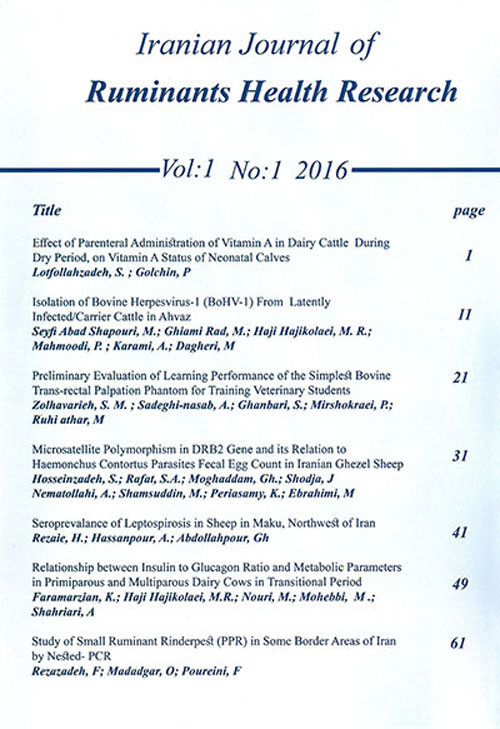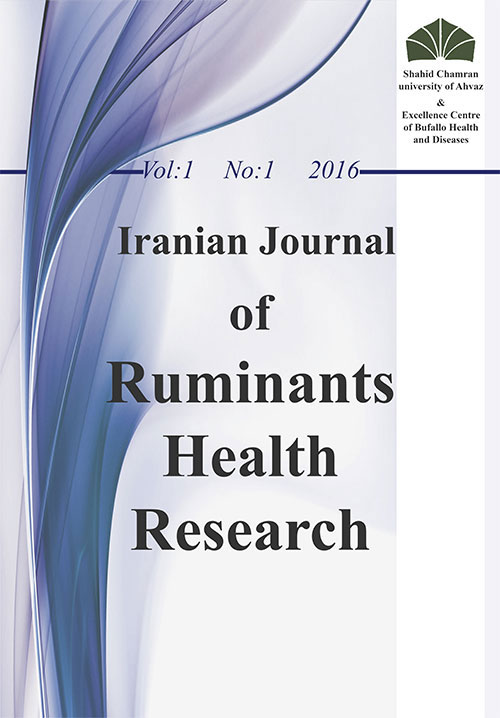فهرست مطالب

Journal of Ruminants Health Research
Volume:1 Issue: 1, Winter and Spring 2016
- تاریخ انتشار: 1395/02/23
- تعداد عناوین: 7
-
-
Pages 1-10The present study has been conducted to evaluate the effect of intramuscular administration of vitamin A during dry period in pregnant dairy cows which have already received it in their daily ration on vitamin A status of neonatal calves.Single intramuscular injection of 2000000 IU vitamin A was carried in 10 dairy cows at 7 months of pregnancy (group 1) and in another 10 dairy cows at 8 months of pregnancy (group 2). Ten pregnant dairy cows received saline injection as placebo and were selected as the control group. Blood samples were collected from dairy cows at 7 and 8 months of pregnancy as well as their newborn calves pre and after colostrum intake.Vitamin A concentration of calves of two treatment groups before and after receiving of colostrum were significantly higher than that in control group (PKeywords: Vitamin A, Dairy cow, Far off, Close up, Calf
-
Pages 11-20Bovine herpesvirus 1 (BoHV-1) is one of the most important infectious viruses of cattle which is considered as the causative agent of several clinical conditions in this species. Hence, we tried to isolate a local strain of the virus from carrier cattle in Ahvaz based on a strategy for reactivation of the latent infection in hosts having antibodies against the virus. Thus, 20 cattle were examined to identify seropositive animals using virus neutralization test (VNT). Afterward, 4 out of 8 seropositive cattle were selected and experimentally stressed by daily injection of Dexamethasone up to five days. Following the injection of Dexamethasone, nasal swabs were collected during 10 days and applied for virus isolation in cell culture. The results showed that one of the stress-induced animals shed the virus on days 8, 9 and 10 after injection of Dexamethasone. Identification of the reactivated virus was carried out based on the virus-induced cytopathic effects in cell culture and PCR and the results were confirmed by sequencing of the PCR product. Isolation of such a local strain of the virus can improve our understanding about circulating BoHV-1 strains in the country.Keywords: BoHV, 1, latent infection, Dexamethasone, Virus reactivation, Virus isolation, Ahvaz
-
Pages 21-30Traditionally, animal exploitation in veterinary education in disciplines such as obstetrics is common worldwide. In addition, it is clear that veterinary schools are expected to provide sufficient opportunity for developing students necessary skill in bovine trans-rectal palpation by graduation. However, the veterinary medical education should be refined and animal exploitation in education be superseded by using non-harmful alternatives. Thus, a phantom was developed as a potential alternative to overcome the present educational problem in Bu-Ali Sina University.The phantom was composed of a fiberglass rear-half of the cow that was designed with detailed inside structures of pelvis and abdominal cavity of cow. Two opening on the cranial and dorsal aspects of the phantom were made to provide proper guidance while an instructor followed a students hand movement. By installing a slaughterhouse-derived cow reproductive tract inside the pelvis and a real rectum above it, an approximately real environment was provided. To find out how it can be useful in the training of students on cow trans-rectal examination, 31 veterinary theriogenologists and 110 fifth-year veterinary students were asked to fill out a developed attitude questionnaire anonymously. The results of instructors'' and students'' responses to the questionnaire indicated that the Phantom provided approximately a realistic physical environment and a comfortable and satisfying approach for teaching/learning cow trans-rectal examination. Accordingly, we can embed the phantom as a supplementary teaching tool in the bovine reproduction course of veterinary medical curriculum.Keywords: Cow, Bovine trans, rectal palpation, Education, Phantom, Slaughterhouse, derived reproductive tract
-
Pages 31-39Gastrointestinal parasites are one of the main sources of economic decline in sheep production around the world. Resistant sheep do not completely reject the disease; they only harbor fewer parasites than susceptible sheep and therefore have a lower fecal egg count. The present research was designed to evaluate microsatellite polymorphism in intron 5 of DRB2 gene and its correlation with H. contortus fecal egg counts in Ghezel sheep breed. For this reason, blood samples were taken from 80 male lambs between 4-6 months of age and some phenotypic traits including fecal egg counts (FEC), FAMACHA test, and packed cell volume (PCV) were measured. Blood DNA was extracted using chloroform-isoamyl alcohol protocol; then, microsatellite regions in intron 5 of DRB2 gene were replicated. Afterward, 3% agarose gel electrophoresis using ethidium bromide staining was performed to evaluate 25 base pairs allele size products using UVidoc software. Finally, the correlation between genotype and phenotypic traits was analyzed by linear and nonlinear mixed models using SAS software. The results showed that lambs having present genotype homozygous 300 were low FEC with lower prevalence of this kind of parasite than lambs having other types of homozygous genotypes. Based on the results, correlation between FAMACHA and PCV was -0.625 (pKeywords: DRB2 gene, FAMACHA test, Ghezel Breed, H. contortus, Microsatellite
-
Pages 41-47This study was conducted on 210 sheep in Maku area in Iran in order to determine seroprevalence of leptospiral infection. Sera were initially screened at dilution of 1:100 against 8 live serovars of Leptospira interrogans: Pomona, Canicola, Hardjo, Ballom, Icterohaemorrhagiae, Automenalis,Australis and Grippotyphosa using the microscopic agglutination test. The prevalence of leptospiral infection (At titers 100 and 200) was 15.23% in sheep. There was a significant relationship between aging and the incidence of leptospiral infection (PKeywords: Sheep, Seroprevalence, Leptospira, Iran
-
Pages 49-59In order to investigate the relationship between insulin to glucagon ratio and metabolic factors in transitional period of dairy cows, 28 cows heifers with body condition score of 3.25- 3.75 were selected. Dairy cows received close up diet, from 21 days prepartum until parturition and lactation diet according to nutritional requirements after parturition. Blood was sampled at 10 days before and 20 days after parturition. BCS was assessed again 20 days after parturition. Serum levels of insulin, glucagon, glucose, NEFA, BHBA, triglyceride, cholesterol and albumin were measured. Insulin, glucagon, insulin to glucagon ratio, cholesterol and albumin levels were not significant between pre and postpartum in primiparous and multiparous cows. Glucose, triglyceride and BCS were decreased at 20 days postpartum than 10 days before partum but NEFA and BHBA were increased in both groups. Serum levels of all parameters were not significantly different between primiparous and multiparous cows. No significant correlation between insulin to glucagon ratio and blood metabolites before and after parturition in primiparous and multiparous cows was observed. It seems that insulin to glucagon ratio decreases as a physiologic response in a transitional period for adaptation to increasing demands of glucose, but is not related to NEFA and BHBA. Therefore, although insulin to glucagon ratio decreased, supplying nutrient requirements of dairy cows can decrease negative energy balance.Keywords: Cow, Glucagon, Insulin, Transitional Period
-
Pages 61-72In order to study on small ruminant rinderpest (PPR) in some border areas of Iran, totally 70 blood samples were taken via jugular vein from Kamyaran, Piranshahr, Lahijan, Ghorveh and Bilesavar district, in a tube with EDTA. The sampling was in the flocks located in Iran borders. The samples were sent near the ice container to laboratory. The blood samples included 28 goat and 42 sheep which totally consisted of 45 and 25 female and male respectively. Samples collected from Ghorveh, Lahijan, Billesavar, Kamyaran and Piranshahr were 13, 10, 18, 13, and 16 respectively. In the above mentioned areas, non-specific symptoms of PPR such as high mortality rate, diarrhea that resistant to the treatment, abortion and observation of ulcer in the penis of the male animals were observed. Sampling was not only from suspected animals but also was done with animals with no specific clinical signs (apparently normal sheep and goats). Blood samples centrifuged at 4° C in 3000 rpm for 10 minutes and serum was separated quietly. Buffy coat was used for extracting PPRV (RNA). RT-PCR was performed by using 448bp that is specific for F gene. In the second step, all samples were tested with Nested-PCR. Live attenuated vaccine was used as a positive control in PCR. Statistical analysis of data was done by SPSS and analysis of variance. Out of 70 samples, N=10 (15%) were positive in the PCR tests. The infection in sheep and goat was N=4 (%10) and N=6 (%22) respectively. No significant differences (P>0/05), were observed between the gender and infection. In the age group of less than 1, 1-2, 2-3 and over 3 years-old, infection rate was %14, 5 %34, 2 %12 and %0, respectively presenting no significant difference (P>0/05). The infection rate in Ghorveh, Lahijan, Billesavar, Kamyaran and piranshahr, was %30, %0, %30, %20 and %20, respectively. The analysis showed that there were no significant differences between the flocks in the locations (P>0/05). Other studies are suggested to be done in different borders of Iran to distinguish infection of PPR.Keywords: PPR, Sheep, Goat, Iran


